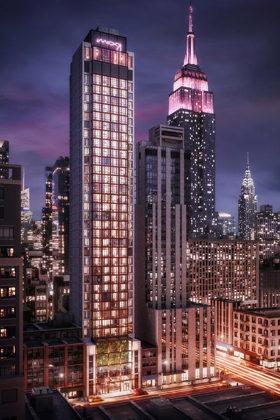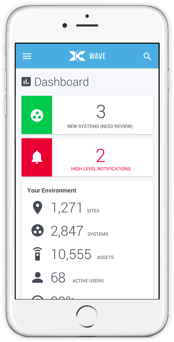During an in-building walk test of all the floors, Klingensmith determined the signal was fine from the third through 37th floor. However, the first and second floors, as well as the cellar and sub-cellar had insufficient signal.
“The Moxy is one of the tallest buildings in that immediate area. The buildings surrounding it are four to five stories so were blocking the signal from getting to the lower floors, but there was a 360-degree view on the upper floors and the signal was good,” says Klingensmith. “The subcellar and the cellar are obviously below-grade so you had zero signal coming into those floors. When you looked at your phone, it actually had the little line going through it saying NO SERVICE.”
So Klingensmith designed a layout for CEL-FI QUATRA that would provide optimal coverage for all four major carriers for the first and second floors, and the cellar and sub-cellar. Each level was 6400 square feet. In total, he installed 4 Network Units (NUs) and 16 Coverage Units (CUs). The CUs were placed at both the front and the back of each of the four floors.
“The concrete walls and the elevator shaft right up the middle of the floor reduce horizontal signal propagation, which is typical in a Manhattan building of this size,” explains Klingensmith. “As a result, each NU served 3,200 square feet per floor. CEL-FI QUATRA provided up to 100dB gain, compared with the 70dB gain provided by passive DAS systems. The difference of 30dB translates to a signal that is 1,000 times stronger.”
To capture the donor signal, Klingensmith installed the dual-feed CEL-FI Wideband Omni Donor antenna on the ledge outside the third floor.
“Through trial and error, we discovered that we needed to be at ground level, or as low as possible to pull in the donor signal due to the density of macro sites,” he says. “This minimizes the number of sites that you can see. The NUs were located in the sub-cellar, so we ran two donor cable runs from the outside into the mechanical room on the third floor, and then we ran them all the way into the sub-cellar.”
The installation took place in two stages. In the earlier phase of construction, Klingensmith and his team of five installers ran category cable through the open walls and ceilings. As construction evolved, they returned to install the CUs, NUs, and donor antenna. The CEL-FI WAVE remote monitoring and management platform proved to be invaluable during the installation process.
“When we lit up the system, we discovered that one of the category cables had been nicked during construction. CEL-FI WAVE enabled us to quickly diagnose the problem,” says Klingensmith. “With passive DAS technology, we have to take a reactive approach and wait for the client to tell us it’s not working. From there, we could have 100 possible points of failure, and we have to troubleshoot them one by one. With CEL-FI QUATRA, we know exactly where the problem originates and we can fix it immediately. This saves us hours of troubleshooting time.”
In total, Klingensmith estimates the entire installation took 18 man-hours to install QUATRA after the cables were laid. A Passive DAS system could have easily taken double the amount of time to install.



